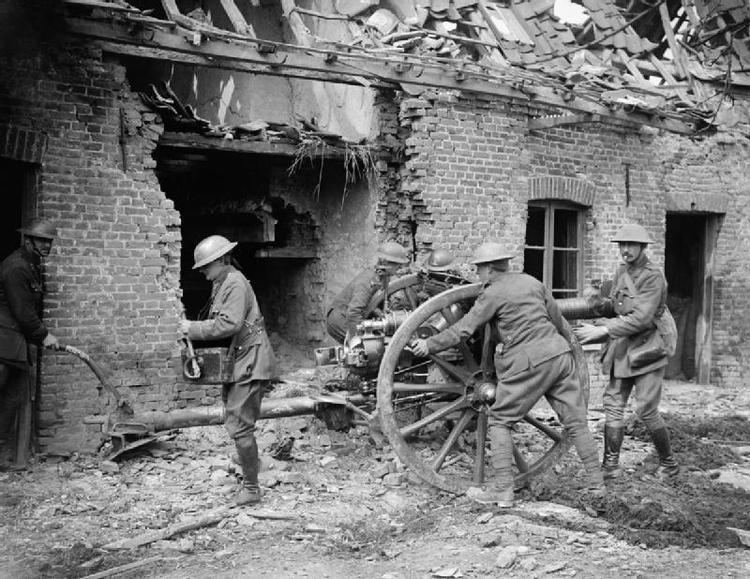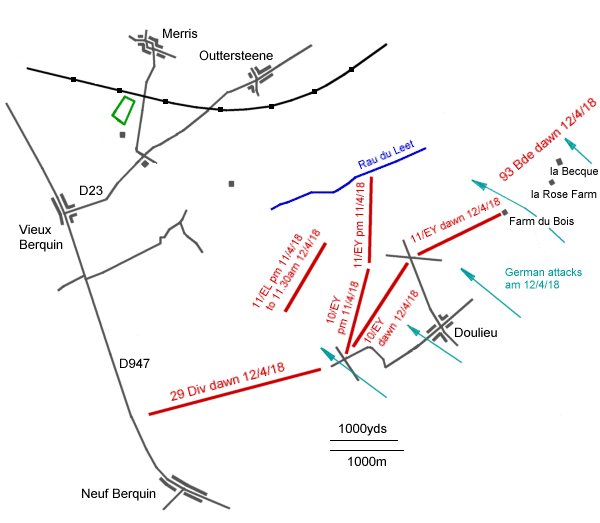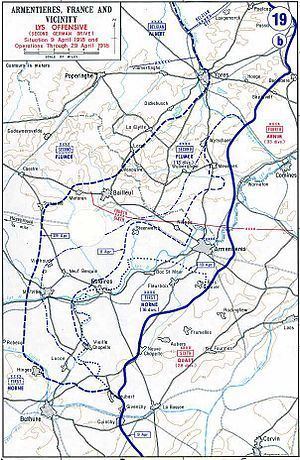c. 120,000 120,000 Result German defeat | Dates 9 Apr 1918 – 29 Apr 1918 | |
 | ||
Similar World War I, Western Front, Battle of Arras, First Battle of the Aisne, First Battle of Ypres | ||
Battle of the lys 1918
The Battle of the Lys (7–29 April 1918), also known as the Lys Offensive, the Fourth Battle of Ypres, the Fourth Battle of Flanders and Operation Georgette (Portuguese: Batalha de La Lys and French: 3ème Bataille des Flandres), was part of the 1918 German offensive in Flanders during World War I, also known as the Spring Offensive. It was originally planned by General Ludendorff as Operation George but was reduced to Operation Georgette, with the objective of capturing Ypres, forcing the British forces back to the channel ports and out of the war. In planning, execution and effects, Georgette was similar to (although smaller than) Operation Michael, earlier in the Spring Offensive.
Contents
- Battle of the lys 1918
- Strategic developments
- Tactical developments
- German plan of attack
- Battle of Estaires 911 April
- Battle of Messines 1011 April
- Battle of Hazebrouck 1215 April
- Battle of Bailleul 1315 April
- First Battle of Kemmel 1719 April
- Battle of Bthune 18 April
- Second Battle of Kemmel 2526 April
- Battle of the Scherpenberg 29 April
- Analysis
- Casualties
- References

Battle of the lys 1918
Strategic developments

The German attack zone was in Flanders, from about 10 kilometres (6.2 mi) east of Ypres in Belgium to 10 kilometres (6.2 mi) east of Béthune in France, about 40 kilometres (25 mi) south. The front line ran from north-north-east to south-south-west. The Lys River, running from south-west to north-east, crossed the front near Armentières in the middle of this zone. The front was held by the Belgian Army in the far north, by the British Second Army (under Plumer) in the north and centre and by the British First Army (under Horne) in the south.
Tactical developments

The German attacking forces were the Sixth Army in the south (under Ferdinand von Quast), and the Fourth Army in the north (under Sixt von Armin). Both armies included substantial numbers of the new stosstruppen, trained to lead attacks with the new stormtroop tactics.

The British First Army was a relatively weak force; it included several worn-out formations that had been posted to a "quiet sector". This included two divisions of the Portuguese Expeditionary Corps, which were undermanned, lacked almost half of their officers, had very low morale and were set to be replaced the day of the German attack.
German plan of attack

The German plan was to break through the First Army, push the Second Army aside to the north, and drive west to the English Channel, cutting off British forces in France from their supply line which ran through the Channel ports of Calais, Dunkirk and Boulogne.
Battle of Estaires (9–11 April)

The German bombardment opened on the evening of 7 April, against the southern part of the Allied line between Armentières and Festubert. The barrage continued until dawn on 9 April. The Sixth Army then attacked with eight divisions. The German assault struck the Portuguese Second Division, which held a front of about 11 kilometres (6.8 mi). The Portuguese division was overrun and withdrew towards Estaires. The British 55th Division, to the south of the Portuguese in a more defensible position, pulled back its northern brigade and held its ground for the rest of the battle, despite attacks from two German reserve divisions. The British 40th Division (to the north of the Portuguese) collapsed under the German attack and fell back to the north.
Horne committed his reserves (First King Edward's Horse and the 11th Cyclist Battalion) to stem the German breakthrough but they too were defeated. The Germans broke through 15 kilometres (9.3 mi) of front and advanced up to 8 kilometres (5.0 mi), the most advanced probe reaching Estaires on the Lys. There they were finally halted by British reserve divisions. On 10 April, the Sixth Army tried to push west from Estaires but was contained for a day; pushing north against the flank of the Second Army, it took Armentières.
Battle of Messines (10–11 April)
Also on 10 April, German Fourth Army attacked north of Armentières with four divisions, against the British 19th Division. The Second Army had sent its reserves south to the First Army and the Germans broke through, advancing up to 3 kilometres (1.9 mi) on a 6 kilometres (3.7 mi) front, and capturing Messines. The 25th Division to the south, flanked on both sides, withdrew about 4 kilometres (2.5 mi). By 11 April, the British situation was desperate; it was on this day that Haig issued his famous "backs to the wall" order.
Battle of Hazebrouck (12–15 April)
On 12 April, the Sixth Army renewed its attack in the south, towards the important supply centre of Hazebrouck, another 10 kilometres (6.2 mi) to the west. The Germans advanced some 2–4 kilometres (1.2–2.5 mi) and captured Merville. On 13 April they were stopped by the First Australian Division, which had been transferred to the area. The British Fourth Division defended Hinges Ridge, the Fifth Division held Nieppe Forest and the 33rd Division was also involved.
Battle of Bailleul (13–15 April)
From 13–15 April, the Germans drove forward in the centre, taking Bailleul, 12 kilometres (7.5 mi) west of Armentières, despite increasing British resistance. Plumer assessed the heavy losses of Second Army and the defeat of his southern flank and ordered his northern flank to withdraw from Passchendaele to Ypres and the Yser Canal; the Belgian Army to the north conformed.
First Battle of Kemmel (17–19 April)
The Kemmelberg is a height commanding the area between Armentières and Ypres. On 17–19 April, the Fourth Army attacked and was repulsed by the British.
Battle of Béthune (18 April)
On 18 April, the Sixth Army attacked south from the breakthrough area toward Béthune but was repulsed.
Second Battle of Kemmel (25–26 April)
French marshal, Foch, had recently assumed supreme command of the Allied forces and on 14 April agreed to send French reserves to the Lys sector. A French division relieved the British defenders of the Kemmelberg.
From 25–26 April, the Fourth Army made a sudden attack on the Kemmelberg with three divisions and captured it. This success gained some ground but it made no progress toward a new break in the Allied line.
Battle of the Scherpenberg (29 April)
On 29 April, a final German attack captured the Scherpenberg, a hill to the north-west of the Kemmelberg.
Analysis
More French reinforcements arrived in the latter part of April, the Germans had suffered many casualties, especially among the stoßtruppen and attacks toward Hazebrouck failed. It was clear that Georgette could not achieve its objectives; on 29 April the German high command called off the offensive.
Casualties
In 1937 C. B. Davies, J. E. Edmonds and R. G. B. Maxwell-Hyslop, the British official historians gave casualties from 9–30 April as c. 82,000 British and a similar number of German casualties. Total casualties since 21 March were British: c. 240,000, French: 92,004 and German: 348,300. In 1978 Middlebrook wrote of 160,000 British casualties, 22,000 killed, 75,000 prisoners and 63,000 wounded. Middlebrook estimated French casualties as 80,000 and German as c. 250,000 with 50–60,000 lightly wounded. In 2002 Marix Evans recorded 109,300 German casualties and the loss of eight aircraft, British losses of 76,300 men, 106 guns and 60 aircraft and French losses of 35,000 men and twelve guns. In 2006 Zabecki gave 86,000 German, 82,040 British and 30,000 French casualties.
